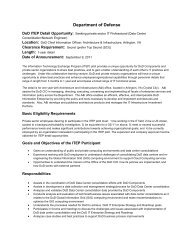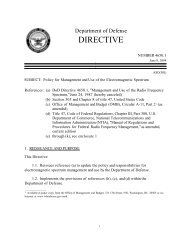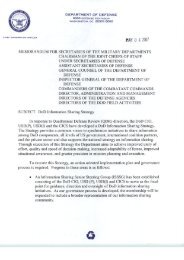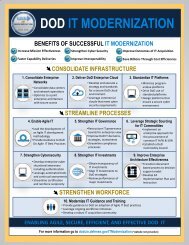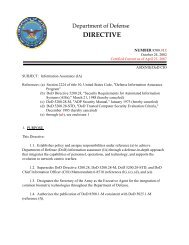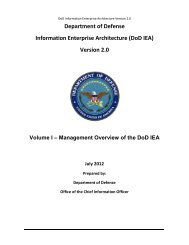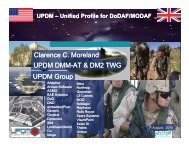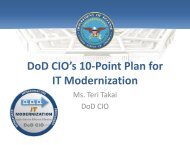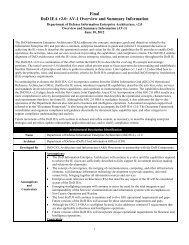DoD Architecture Framework Version 1.5 - Chief Information Officer
DoD Architecture Framework Version 1.5 - Chief Information Officer
DoD Architecture Framework Version 1.5 - Chief Information Officer
Create successful ePaper yourself
Turn your PDF publications into a flip-book with our unique Google optimized e-Paper software.
2 ARCHITECTURE DEVELOPMENT<br />
2.1 ARCHITECTURE GUIDELINES<br />
In order to support the requirements of stakeholders, it is effective to start with a common set<br />
of principles and a practical set of expectations for architecture. The following set of guiding<br />
principles is critical to the development of useful and practical architectures that can be<br />
integrated or federated for use by program, <strong>DoD</strong> Component, mission, and enterprise-level<br />
decision makers.<br />
2.1.1 Have a Purpose in Mind<br />
An architecture should have a specific and commonly understood purpose to increase the<br />
efficiency of the effort and the utility of the resulting description. The purpose determines the<br />
scope, which drives the specification of characteristics, time frames, data requirements, and level<br />
of detail or granularity. It should align with the priorities of the community and contribute to the<br />
success of mission goals and objectives. This principle applies equally to the description of an<br />
architecture as a whole or to any portion or view of an architecture. It also applies to groups of<br />
architectures within a federation or enterprise. For example, if architectures built by various<br />
organizations are to be compared, it is important that they all be built from the start with the<br />
purpose of comparison in mind.<br />
2.1.2 Be Simple and Straightforward<br />
Developing overly complex architectures is costly in both time and money. Focusing the<br />
architecting effort is essential to obtain an acceptable return on investment. Care should be given<br />
in determining the level of detail appropriate for achieving the desired objectives of the<br />
architecture effort. The following are some of the areas that should be considered:<br />
• Scope of the architecture<br />
• Levels of decomposition for the architecture<br />
• Level of specificity in defining architecture data elements<br />
2.1.3 Be Understandable Among <strong>Architecture</strong> Users<br />
<strong>Architecture</strong>s should be understandable so as to enhance the applicability of the information<br />
among architecture users. They should guide the human thinking process in discovering,<br />
analyzing, and resolving issues so that architects and analysts understand them quickly.<br />
<strong>Architecture</strong>s should provide a clear representation of the information by using common terms<br />
and definitions and avoiding extraneous information. Architects should look to their COIs for<br />
these common terms and definitions.<br />
2.1.4 Be Interoperable Across the <strong>DoD</strong><br />
<strong>Architecture</strong>s should be expressible using a standard vocabulary with unambiguous<br />
semantics and a well defined data structure to enable comparability and interoperability across<br />
independently developed models throughout the <strong>DoD</strong>. This principle requires the use of a<br />
common set of architectural building blocks or reference documents as the basis for architecture<br />
descriptions. It is critical that architecture descriptions clearly describe external interfaces with<br />
Joint, multinational, and commercial components in a manner consistent with the method used to<br />
describe internal relationships. This common foundation for development ensures the use of<br />
similar formats for displaying information enabling the integration, federation, comparison, and<br />
reusability of disparate architectures.<br />
2-1




